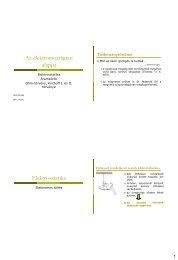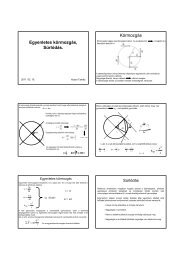Motor proteins, cellular motility Regulation of actin treadmilling
Motor proteins, cellular motility Regulation of actin treadmilling
Motor proteins, cellular motility Regulation of actin treadmilling
You also want an ePaper? Increase the reach of your titles
YUMPU automatically turns print PDFs into web optimized ePapers that Google loves.
04/10/2013<br />
<strong>Motor</strong> <strong>proteins</strong>, <strong>cellular</strong> <strong>motility</strong><br />
Common characteristics and types <strong>of</strong> motor <strong>proteins</strong>.<br />
The ATPase cycle.<br />
Properties, function and partner <strong>proteins</strong> <strong>of</strong> the different motor<br />
<strong>proteins</strong>.<br />
25.09.2013.<br />
<strong>Regulation</strong> <strong>of</strong> <strong>actin</strong> <strong>treadmilling</strong><br />
Le Clainche C, Carlier MF. <strong>Regulation</strong> <strong>of</strong> <strong>actin</strong> assembly associated with protrusion and adhesion in cell migration. Physiol Rev. 2008 Apr;88(2):489-513.<br />
1
04/10/2013<br />
<strong>Motor</strong> <strong>proteins</strong><br />
• Proteins that can bind to specific filaments<br />
• chemo-mechanical enzymes (mechanochemical coupling)<br />
− they hydrolyze ATP (chemical energy)<br />
− they can produce kinetic energy<br />
• Their thermodynamic efficiency is between 30 and 60%.<br />
• They convert chemical energy to mechanical work directly.<br />
• The cytoskeletal filaments:<br />
− Serve as tracks to carry organelles or vesicles<br />
− Can be moved by the motor <strong>proteins</strong><br />
Families <strong>of</strong> motor <strong>proteins</strong><br />
Cytoskeletal motors<br />
• Actin-based motors (myosins)<br />
• Microtubule based motors (kinesins and dyneins)<br />
Non-cytoskeletal motors<br />
• Nucleic acid based (DNA and RNA polymerases,<br />
helicases)<br />
• Rotary motors: bacterial flagellum, FI-F0-ATPase<br />
2
04/10/2013<br />
Basic components <strong>of</strong> the<br />
cytoskeletal transport system<br />
• <strong>Motor</strong><br />
− Myosin, kinesin, dynein<br />
• Track<br />
− Micr<strong>of</strong>ilaments, microtubules<br />
• Cargo<br />
− organelles, chromosomes, vesicles<br />
• Fuel<br />
− ATP, GTP<br />
Common properties<br />
Structure<br />
• N-terminal globular head:<br />
motor domain<br />
− nucleotide binding and hydrolysis<br />
− specific binding sites for the corresponding filaments<br />
• C-terminal: structural and functional role with specificity<br />
N<br />
C<br />
Mechanical properties, function<br />
In principle: cyclic function and work<br />
<strong>Motor</strong> → binding to a filament → force → dissociation → relaxation<br />
1 cycle requires 1 ATP hydrolysis<br />
They can either move or produce force<br />
3
04/10/2013<br />
Directionality<br />
• Track polarity: + and – ends <strong>of</strong> the <strong>actin</strong> filaments and the<br />
microtubules<br />
• <strong>Motor</strong>s move unidirectionally<br />
−<br />
−<br />
−<br />
myosin: toward the + end <strong>of</strong> micr<strong>of</strong>ilaments<br />
kinesin: toward the + end <strong>of</strong> microtubules<br />
dynein: toward the – end <strong>of</strong> microtubules<br />
Myosins<br />
• Actin-based motors<br />
• conventional myosins (myosin II – 1864: Wilhelm Kühne)<br />
• nonconventional myosins<br />
• Myosin families: myosin I-XVIII<br />
• Functions:<br />
− muscle contraction<br />
− cytokinesis<br />
4
04/10/2013<br />
Myosin II<br />
Head: <strong>actin</strong> binding and<br />
nucleotide binding region<br />
Neck<br />
Tail<br />
S1 head tilting model<br />
• S1 head attaches to the <strong>actin</strong> filament<br />
• The angle <strong>of</strong> attachment change from 90° to 45° → sliding <strong>of</strong> the filament<br />
• detachment<br />
Huxley AF, Simmons RM. Proposed mechanism <strong>of</strong> force generation in striated muscle. Nature. 1971 Oct 22;233(5321):533-8<br />
5
04/10/2013<br />
S1 head tilting model<br />
Huxley AF, Simmons RM. Proposed mechanism <strong>of</strong> force generation in striated muscle. Nature. 1971 Oct 22;233(5321):533-8<br />
The swinging lever arm model<br />
• Rigor-dissociation step: ATP binding → dissociation form the <strong>actin</strong> filament<br />
• Priming (back swing) <strong>of</strong> the lever arm<br />
• ATP hydrolysis: reattachment<br />
• Power stroke: force generating swing <strong>of</strong> the lever arm<br />
MECHANOCHEMICAL COUPLING!<br />
Kühner S, Fischer S. Structural mechanism <strong>of</strong> the ATP-induced dissociation <strong>of</strong> rigor myosin from <strong>actin</strong>. Proc Natl Acad Sci U S A. 2011 May 10;108(19):7793-8.<br />
6
04/10/2013<br />
• 1985: Ron Vale<br />
• XIV kinesin families<br />
• microtubule based motor <strong>proteins</strong><br />
• They move towards the plus end <strong>of</strong> MT<br />
• Functions:<br />
− organelle movement<br />
− Assembly <strong>of</strong> cilia and flagella<br />
−<br />
−<br />
Kinesins<br />
Signaling pathways<br />
Mitotic spindle formation and transportation <strong>of</strong> the<br />
chromosomes<br />
• The end!<br />
7



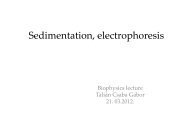
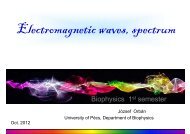
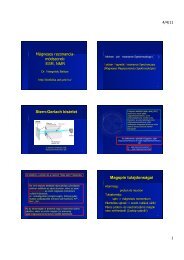
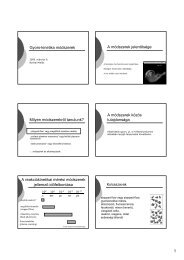
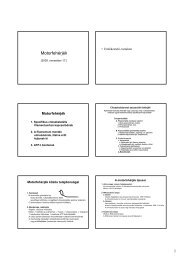

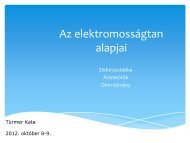
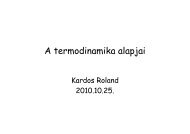
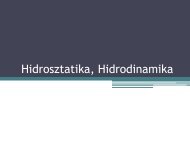

![Microsoft PowerPoint - Intermedier filamentumok [Kompatibilis m\363d]](https://img.yumpu.com/17119137/1/190x135/microsoft-powerpoint-intermedier-filamentumok-kompatibilis-m363d.jpg?quality=85)
